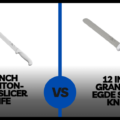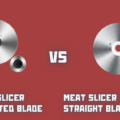As a beginner chef, understanding and mastering the different cuts of meat is a vital culinary skill. The cut of meat influences its taste and texture and determines the best cooking method to maximize flavor and tenderness. Whether beef, pork, chicken, or lamb, each animal has unique cuts that can be prepared in various ways to bring out the best in your dishes. Knowledge of these cuts can enhance your versatility in the kitchen and broaden your culinary repertoire.
Cuts Of Meat All Beginner Chefs Should Know And Master
- Beef: Regarding beef, there are several popular cuts that every chef should be familiar with. Here are four of the most common and sought-after cuts.
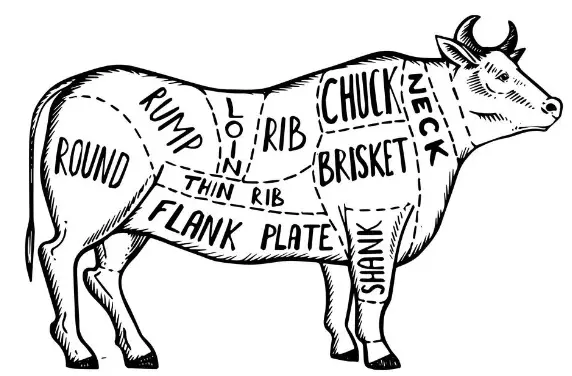
Different cuts of Beef - Filet Mignon: This tender and lean cut of beef comes from the smaller end of the tenderloin. It’s melt-in-your-mouth texture and delicate flavor make it a favorite among steak lovers. To ensure a perfect medium-rare center, filet mignon is best cooked using high-heat methods, such as grilling, broiling, or pan-searing.
- Ribeye: A ribeye is a rich, marbled cut of beef with intense flavor and tenderness. It’s taken from the rib section and is known for its beautiful marbling, contributing to its juiciness and flavor. Ribeyes are best prepared using dry-heat cooking methods, such as grilling or pan-searing, to bring out their natural flavors.
- New York Strip: This popular cut is known for its tenderness and robust flavor. It comes from the short loin located just behind the rib. The New York strip is a versatile cut that can be grilled, broiled, or pan-seared, and it pairs well with various sauces and seasonings.
- T-bone: The T-bone is a large cut consisting of two types of meat: the tenderloin and the strip steak. It’s named after the T-shaped bone that separates the two cuts. This cut is best cooked on a grill or a cast-iron skillet to achieve a perfect sear and a delicious, juicy center.
- Pork: Pork is another versatile and flavorful meat that every beginner chef should know. Here are some popular pork cuts and how to cook them.
- Pork Tenderloin: The pork tenderloin is a lean and tender cut from the back of the animal. It’s perfect for quick-cooking methods, such as grilling or pan-searing, and is great for slicing into medallions or stir-fries.
- Bacon: Bacon is a favorite among many, and it’s derived from the belly of the pig. It’s typically cured, smoked, and sliced thin. Bacon can be cooked in various ways, including frying, baking, or grilling. It’s often used to add flavor and texture to other dishes or enjoyed as a breakfast staple.
- Chicken: Chicken is a versatile and affordable option for beginner chefs. Here are the four most common cuts of chicken to master.

Different cuts of chicken - Breast: Chicken breasts are lean, boneless cuts of meat from the bird’s chest. They’re a popular choice due to their versatility and mild flavor. Chicken breasts baked, pan-seared, or poached. Be careful not to overcook them; they quickly become dry and tough.
- Thigh: Chicken thighs are dark meat cut from the upper part of the bird’s leg. They’re more flavorful and juicier than chicken breasts, making them popular for many dishes. Thighs can be cooked with or without the bone and skin, and they’re suitable for various cooking methods, such as grilling, baking, or braising.
- Drumstick: Drumsticks are another dark meat cut from the lower part of the chicken’s leg. They’re known for their rich flavor and tender texture. Drumsticks can be cooked with or without the skin and are perfect for grilling, baking, or frying. They’re also popular for slow-cooker recipes, as they become incredibly tender when cooked longer.
- Wing: Chicken wings are a popular appetizer and finger food. They come from the upper part of the bird’s wing and are usually sold in three sections: the drumette, the flat, and the tip. Wings can be baked, grilled, or fried and are often served with flavorful sauces.
- Chuck Roast: This cut is one of the most versatile and economical. It comes from the shoulder, which means it can be a bit tough, but slow cooking methods like braising or roasting will help to tenderize it.
- Ribeye Steak: This cut comes from the rib section and has lots of marbling, giving it a rich flavor and juicy texture. It’s best cooked in a hot skillet or grilled over high heat for a delicious steak dinner.
- Pork Shoulder: This cut is perfect for slow cooking methods like braising and stewing, as it has many connective tissues that break down when cooked low and slow. The result is a super tender and flavorful piece of meat.
- Boneless Skinless Chicken Thighs: These cuts are great for pan-frying or baking as they have a high-fat content that makes them nice and juicy. Just cook them through until the internal temperature is 165 F for food safety.
- Flank Steak: This cut of meat is usually thin and long, low in fat, with more intense flavor than other cuts. Flank steak works great for recipes that call for the marinade, as the small pieces will readily absorb flavors from the marinade. It is best cooked quickly over high heat and should be sliced against the grain before serving.
- Loin: A loin is a section of the body on both sides of the spine and is usually composed of two relatively tender muscles. It’s often used to make steaks, such as T-bone, sirloin, porterhouse, strip steak, and club steak. The tenderloin is the most tender cut because it contains less muscle, making it much easier to chew. The loin can also be used for roasts, like a standing rib roast or pork loin. When selecting a loin cut, look for cuts with plenty of fat and marbling, as those will help keep the meat moist while cooking.
Miscellaneous Cuts
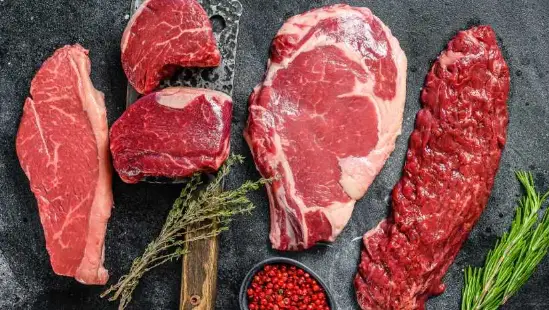
- Tongue: This cut is usually taken from the animal’s tongue and has a thick, almost rough texture. It requires careful preparation as it tends to be tough and must be cooked low and slow to become tender.
- Cheeks: This type of cut, also known as the jowl, is a fatty, flavorful cut from the face of the animal. It can be braised or simmered in liquid until tender and served with mashed potatoes or vegetables.
- Oxtail: Oxtail is a cut of meat from the tail end of cattle. It’s a flavorful, fatty cut that requires long cooking times to tenderize and make eating enjoyable. Oxtail is most commonly used for making soups, stews, and braises.
- Neck: Neck cuts are some of the toughest, cheapest, and most flavorful cuts available. These cuts are often used to make stews and soups because they require slow cooking to break down the tougher muscles. The neck is typically sold in chunks or as a rolled roast, which can then be cooked as-is or cut up into individual steaks.
- Heart: Heart meat is rich in iron, zinc, and B vitamins source. It can be prepared either grilled or braised. To prepare the heart, it is important to thoroughly clean the organ before cooking. When cooked correctly, the heart has a bold flavor and chewy texture that pairs well with various sauces and sides.
FAQs
What is the most tender cut of beef?
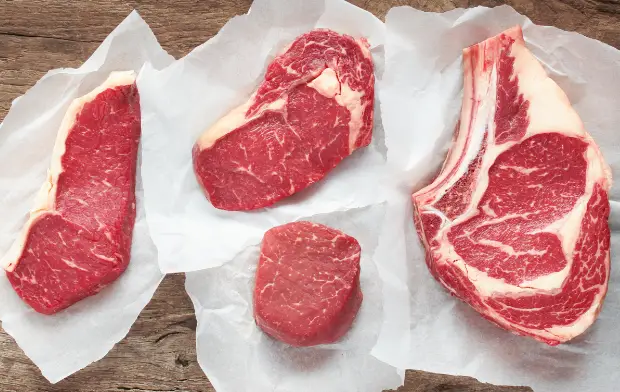
The filet mignon is considered the most tender cut of beef thanks to its fine texture and delicate flavor.
What is the difference between a pork loin and a pork tenderloin?
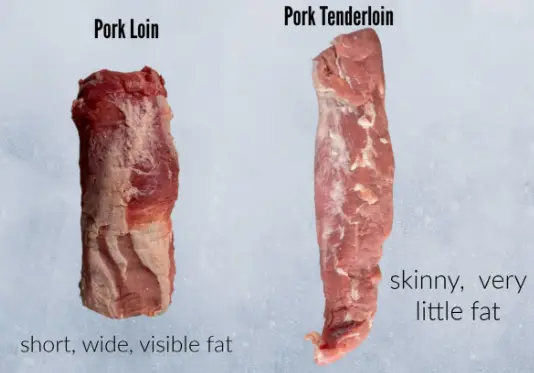
Pork loin is a larger, wider cut of meat from the back of the animal, while pork tenderloin is a smaller, leaner cut that comes from the muscle alongside the backbone.
Which is healthier: chicken breast or thigh?
Chicken breast is lower in fat and calories, making it a healthier option than the thigh. However, the thigh has more flavor and is juicier, which may be preferable for some dishes.
Can I substitute one cut of meat for another in a recipe?
Substituting cuts of meat can sometimes work, but it’s important to consider the dish’s cooking method and desired texture and flavor. For example, swapping a lean cut like filet mignon for a fattier cut like ribeye will change the dish’s flavor and texture.
How can I prevent overcooking meat?
Use a meat thermometer to ensure your meat is cooked to the desired internal temperature. Also, consider the cooking method and be mindful of cooking times to avoid overcooking.
Conclusion
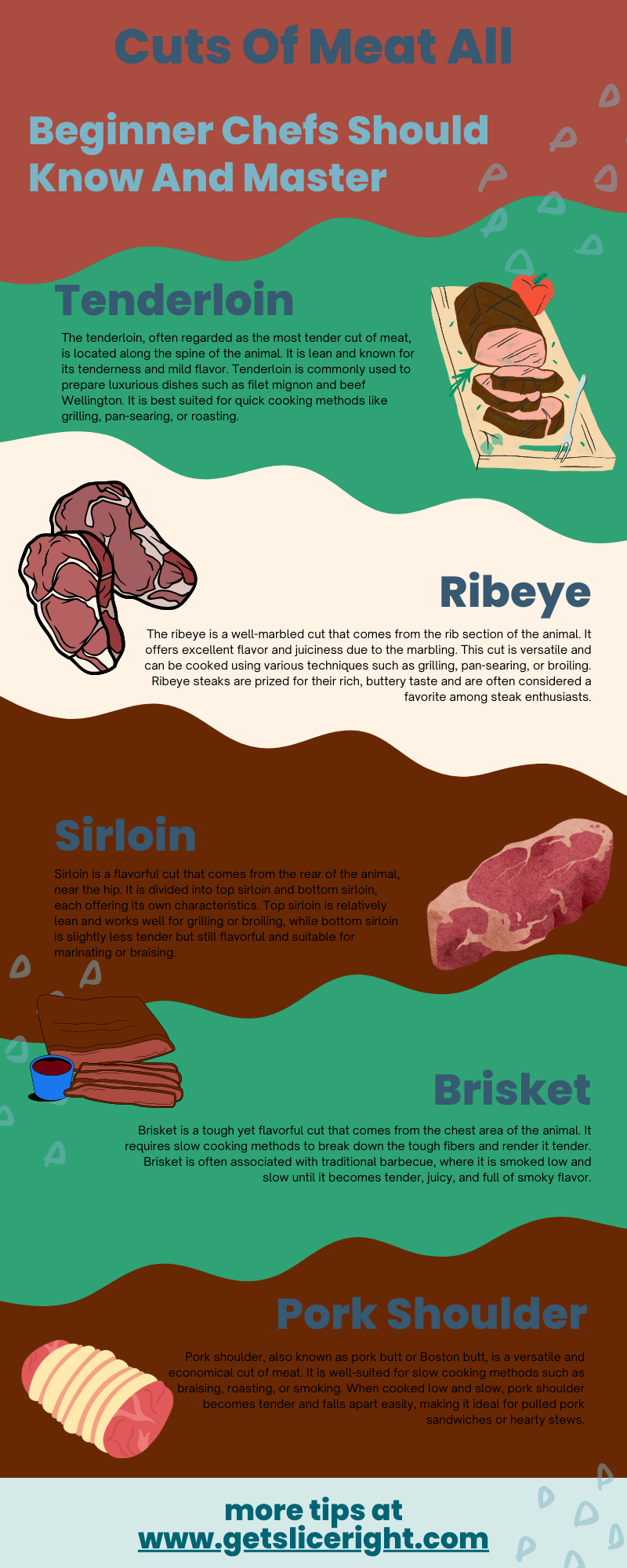
Understanding the various cuts of meat is essential for any beginner chef looking to create mouthwatering dishes. By familiarizing yourself with these popular beef, pork, and chicken cuts, you can choose the best cut for your dish and cook it perfectly. So get in the kitchen and start mastering these cuts of meat – your taste buds will thank you.

Mario Batali is a renowned author, food enthusiast, and passionate chef who has dedicated his life to exploring the world of culinary arts. With a love for sharing his knowledge and experiences, Mario has become a prominent figure in the food blogging community, inspiring countless readers with his creativity and expertise.
In addition to his culinary prowess, Mario Batali is also a talented writer with a flair for engaging storytelling. He launched his own food blog to share his recipes, cooking tips, and personal experiences in the kitchen. Over time, Mario’s blog gained a loyal following of food enthusiasts who appreciate his unique approach to cooking and his dedication to using only the finest ingredients.
Mario Batali’s passion for food and his commitment to sharing his knowledge with others have made him a true inspiration in the world of culinary arts. Through his blog, cookbooks, and public appearances, Mario continues to spread his love of food and the joy of cooking with his ever-growing fanbase.



